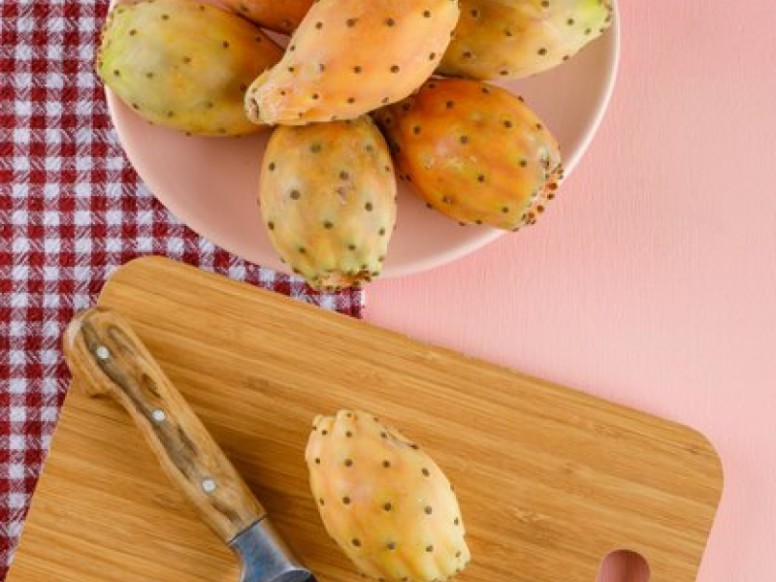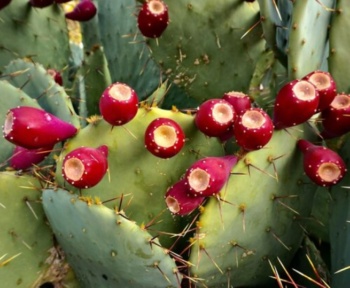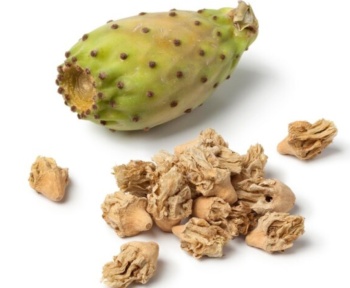Introduction
Prickly pear, also known as cactus fruit, might look like it came straight from an alien planet, but trust me, it’s worth trying. With its sweet and tangy flavor and vibrant colors, it’s no wonder this fruit is becoming more popular. If you’ve been eyeing it at the store and wondering how to deal with all those spines, I’m here to help you figure it out. By this end, you’ll cut, peel, and enjoy prickly pear like a pro.
What Exactly Is Prickly Pear?
Before we get into the cutting and eating, let’s talk about what prickly pear is. It’s the fruit that grows on a cactus (you probably guessed that from the name). It comes in various colors—red, purple, yellow, and even green—but red and purple are the most common. When you slice it open, you’ll find a jelly-like interior with tiny seeds. The taste? Sweet, with a little tang, and the texture is like a cross between a watermelon and a pear, but a bit firmer.
It’s also packed with vitamins and antioxidants, so it’s not just pretty but healthy. Prickly pear is full of fiber and vitamin C, which is good for digestion and boosts your immune system. But let’s be honest, you’re just here for the taste. So, let’s move on to the fun part: how to eat it.

Picking the Best Prickly Pear
Picking a prickly pear is like choosing a watermelon—you want the right texture and color. Here’s how to tell when a prickly pear is ripe:
- Look for Bright Color: If it’s red, pink, or purple, you’re probably good to go. It might need a few more days to ripen if it’s still green.
- Check the Firmness: Squeeze it gently. A ripe, prickly pear will have some give but won’t feel mushy.
- Avoid Large Blemishes: A few small spots are fine, but steer clear of ones with significant, dark blemishes. They’re usually overripe or spoiled.
How to Cut and Peel Prickly Pear
Here’s where things get a little tricky. The skin of the prickly pear has tiny spines called glochids, and you don’t want to get pricked by them. Luckily, cutting and peeling prickly pear is easy with the proper technique.

What You’ll Need:
- A sharp knife
- A cutting board
- Gloves (or tongs) to avoid those prickles

Step-by-Step Process:
- Cut Off Both Ends: First, slice off both ends of the prickly pear. This will give you a flat surface, making it easier and safer to peel.
- Peel the Skin: Next, use your knife to make a shallow cut down the length of the fruit. You only want to cut through the skin, not the flesh. Once you’ve cut, you should be able to peel the skin away easily. Watch out for those little spines; wear gloves to protect your hands.
- Slice the Fruit: After peeling the skin off, slice the fruit into chunks or slices, depending on how you want to eat it. You’ll notice tiny, edible seeds throughout the flesh. You can eat them as-is or discard them, whatever you prefer.
How to Eat Prickly Pear
Now that you’ve peeled and sliced your prickly pear let’s get to the fun part: eating it.
Eat It Fresh
The easiest way to enjoy prickly pear is to eat it fresh. Just cut it up into chunks and enjoy. It’s sweet, refreshing, and packed with water, which makes it a great snack on a hot day. The texture is smooth, and the little seeds add a nice crunch. It’s like biting into a sweet, juicy, naturally hydrating candy.
Smoothies and Juices
If you love smoothies, prickly pear is a fantastic addition. It blends well with other fruits, especially tropical ones like mango, pineapple, and bananas. Just throw some prickly pear in the blender with your favorite liquid (like coconut water or juice), and you’ve got a refreshing drink that’s also good for you.
Add to Salads
Prickly pear isn’t just for smoothies and snacks—it’s also a great salad topper. Cube it up and toss it into a salad for a burst of color and sweetness. It pairs well with leafy greens, cheese (like feta or goat cheese), and even a little citrus dressing. Trust me, it’ll make your salad look and taste more exciting.

Make Prickly Pear Jam or Syrup
If you’re into DIY kitchen projects, prickly pear jam or syrup is an easy and tasty treat. Cook the fruit with sugar and water until it thickens. You can spread it on toast, drizzle it over pancakes, or mix it into yogurt for a sweet kick.

Tips for Storing Prickly Pear
So, you’ve got your prickly pear, but what if you don’t eat it all at once? Here’s how to store it:
- Whole Fruit: If you’re not ready to eat it, whole prickly pears will be kept in the fridge for 2-3 days. Just pop them in a plastic bag or container to keep them fresh.
- Peeled Fruit: Once peeled, prickly pear pieces can also be stored in the fridge for several days. If you want to keep them longer, freeze the pieces. Lay them on a baking sheet, freeze them until solid, and then transfer them to a freezer-safe container. They’ll stay good for months.
- Drying: If you’re into prepping, you can dry prickly pear. Slice the fruit thinly, dehydrate it, and store the dried pieces in an airtight container.
Handling the Thorns
Here’s a quick note about those spines: they’re tiny but pack a punch. When handling prickly pear, be careful:
- Wear Gloves: The easiest way to avoid getting pricked is to wear gloves. Use tongs or a clean kitchen towel to hold the fruit if you don’t have gloves.
- Brush Off the Thorns: If you get a few tiny thorns stuck to your skin or the fruit, use a soft brush to remove them.
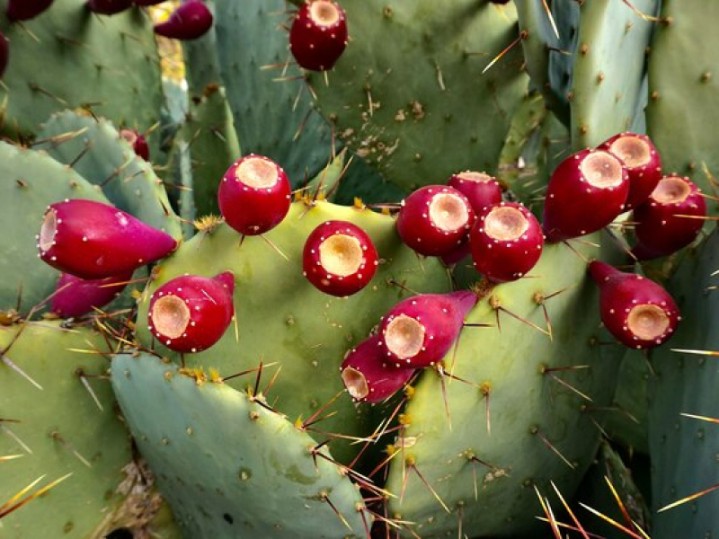
Prickly Pear Health Benefits
Let’s talk about why you should eat prickly pear. Not only is it delicious, but it’s also packed with health benefits:
- Fiber: Prickly pear is high in fiber, which is excellent for digestion. It helps keep things moving and also makes you feel full longer.
- Vitamin C: This fruit is loaded with vitamin C, which helps boost your immune system and keeps your skin healthy.
- Antioxidants: The antioxidants in prickly pear help fight inflammation and protect your body from damage caused by free radicals.
- Low in Calories: Prickly pear is an excellent choice if you’re watching your calorie intake. It’s naturally low in calories so that you can snack on it without guilt.
Prickly Pear in Your Daily Diet
There are plenty of ways to add prickly pear to your daily routine. Here are a few simple ideas:
- Morning Smoothies: Toss some prickly pear into your morning smoothie. Blend it with other fruits like strawberries and bananas for a delicious and refreshing start to your day.
- Salad Toppings: Add prickly pear to your lunchtime salad for a pop of color and sweetness. It pairs well with greens, nuts, and cheese.
- Healthy Dessert: Prickly pear is a healthy alternative to sugary desserts if you crave something sweet after dinner. It’s naturally sweet and low in calories.
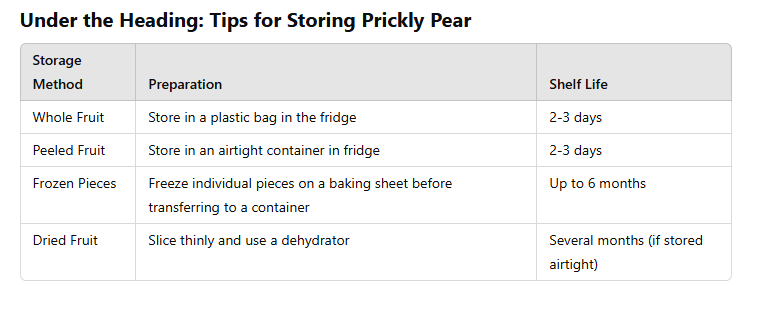
Interview with a Prickly Pear Expert
I contacted a local fruit farmer, Jane Lawson, who grows prickly pear in her orchard. Here’s what she had to say about the fruit:
Q: What’s the best way to tell when a prickly pear is ripe?
Jane: “You want to look for bright colors but squeeze them slightly. If it’s firm but gives a little under pressure, you’ve got a ripe one. If it’s too hard, it’s not ready yet.”
Q: Do you eat the seeds?
Jane: “Yes, the seeds are edible. They’re small and crunchy, adding a nice texture to the fruit. Some people might spit them out, but I like them!”
Conclusion
Now that you know how to cut and eat prickly pear, you have a new fruit to enjoy. Whether snacking on it fresh, blending it into smoothies, or turning it into syrup, there’s no wrong way to eat this fruit. So next time you see it at the store, grab one and try it. You might discover a new favorite.
FAQs
Yes, you can eat the seeds! They’re small and crunchy, adding texture to the fruit.
Look for bright colors and give it a gentle squeeze. It should feel firm but have a little give. If it’s too soft, it’s probably overripe.
Whole prickly pears can be kept in the fridge for up to 3 days. Once peeled, they can be stored in the refrigerator or frozen for extended storage.


